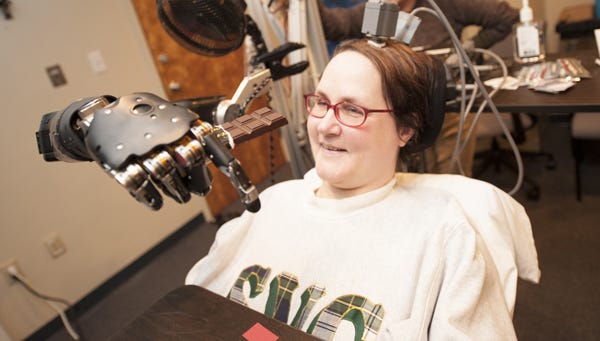How to Fly a Plane with Only Your Thoughts
March 10, 2015
University of Pittsburgh researchers combined a computer-brain interface with a flight simulator, with pretty amazing results.
Nancy Crotti
|
Jan Scheuermann, who has quadriplegia, brings a chocolate bar to her mouth using a robot arm she is guiding with her thoughts. (Photo courtesy of University of Pittsburgh School of Medicine) |
For Jan Sheuermann, the sky's the limit, according to a story on Wired.
First approached by the Defense Advanced Research Projects Agency (DARPA) and the University of Pittsburgh's Human Engineering Research Laboratories in 2012, the woman with quadriplegia learned to control a robotic arm with her mind.
More recently, researchers connected Scheuermann's brain interface to a flight simulator, which she used to pilot the F-35 Joint Strike Fighter, one of the military's newest fighter planes.
The research is part of DARPA's Revolutionizing Prosthetics program, begun in 2006 to advance upper-limb technology to help injured veterans, according to the agency's website.
Sheuermann previously learned to use a robot arm to control a virtual arm on a computer screen. She has a 4-mm-wide sensor embedded in her brain, with each of its 96 microelectrodes trained on a different cell, according to the Wired story. To control the virtual fighter jet, researchers reprogrammed the output of the electrodes to control the altitude, pitch, and roll of an onscreen plane.
When placed on the motor cortex, these microelectrodes "get very close to the cell body and can record whenever one of those cells fire," Justin Sanchez, the DARPA prosthetics program manager, told Wired.
Scheuermann had two such sensors surgically implanted in the regions of her brain that are responsible for right arm and hand movements. Afterward, the electrode grids were connected to a computer, creating a brain-machine interface. The individual contact points pick up pulses of electricity fired between neurons. Computer algorithms decoded these firing signals and identified patterns associated with a particular arm movement, such as raising the arm, or turning the wrist.
This allowed Scheuermann to think of controlling certain arm movements before watching the robotic arm carry out the commands. She could force the robotic arm to reach out to objects, as well as move it in a number of directions while flexing and rotating the wrist.
DARPA may have an exclusive on mind-controlled fighter-jets, but researchers at Duke University published a study in November 2013 in the journal Science Translational Medicine about enabling monkeys to control the movement of both arms on an avatar using just their brain activity.Their work is an effort to develop bilateral movement in brain-controlled prosthetic devices for severely paralyzed patients.
Researchers elsewhere have been able to allow paralyzed people to control robot arms through brain-computer interfaces. Researchers at Ohio State University and the nonprofit Battelle research organization have even figured out how to use such interfaces to allow people to regain control of paralyzed limbs.
Refresh your medical device industry knowledge at BIOMEDevice Boston, May 6-7, 2015. |
Nancy Crotti is a contributor to Qmed and MPMN.
Like what you're reading? Subscribe to our daily e-newsletter.
About the Author(s)
You May Also Like


.png?width=300&auto=webp&quality=80&disable=upscale)
